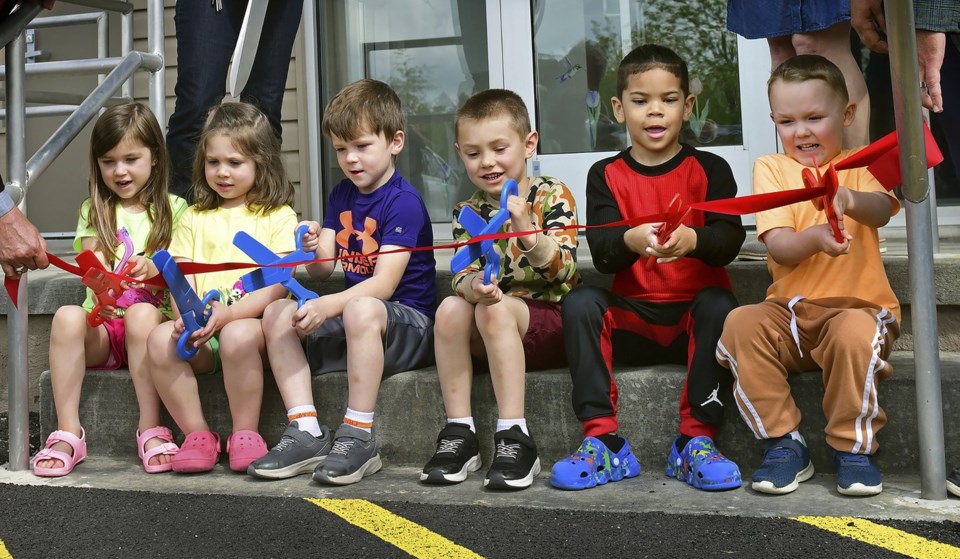Americans overwhelmingly view the cost of child care as a significant issue, and most support initiatives to offer free or low-cost day care and to require employers to provide paid family leave for parents of babies, according to a new poll.
But they're divided over how to solve the problem and what role the government should have in that solution.
About three-quarters of U.S. adults see child care costs as a “major problem,” but only about half say helping working families pay for child care should be a “high priority” for the federal government, according to the June poll from .
The latest congressional included tax credits and benefits for parents and businesses that assist employees with child care. Those changes have been praised by some, while others say millions of families at lower income levels wouldn't get the full credit and would be affected by .
The poll findings help explain the difficulty advocacy groups, elected officials and families navigate in trying to address the high costs of care: While most agree it's a problem, there isn't a simple fix. For instance, while government-funded child care is popular, that might not be everyone's first choice. Many U.S. adults also think it's better for children with two parents to be cared for full time by a parent.
“Everyone kind of agrees that it’s a problem that we need to address,” said Sarah Rittling, executive director of the First Five Years Fund advocacy organization. “By having this issue out there, it really is driving a lot of bipartisan conversations.”
Some consensus on free day care and paid family leave
Most Americans support initiatives to offer child care or additional time for working families to spend with babies. About two-thirds support providing free or low-cost day care for children too young to attend public school, and a similar share favor requiring employers to provide paid family leave for new parents.
Women are more likely than men to support the proposals, and Democrats are more likely than Republicans, but each is popular across the board.
Mary Banek, a nurse anesthetist of Midlothian, Texas, said she helps take care of her 1-year-old grandson so he doesn’t need day care. When she had her kids, she left the workforce and got a license to start a day care from her home to watch 12 children, including her own, so she could generate income.
Banek said she's surprised at the high fees at day cares these days.
“I don’t know what’s happened and why it is so expensive,” Banek said, adding maybe there's a way to cap costs. She doesn't feel the government should foot the cost.
Many think parents should be caregivers
While many solutions focus on families with working parents, there isn't broad agreement this is the best arrangement for children. Just under half of U.S. adults, 45%, say children with two parents are better off when one parent doesn’t have a job and raises the children. Only about 1 in 10 say children are better off when both parents work full time, and about 4 in 10 say it doesn’t make a difference.
Vice President JD Vance has tried to push for ideas that would but has opposed government spending on child care, saying children benefit from having a parent or family member at home as a caretaker.
About half of men say children with two parents are better off when one is the full-time caregiver, compared with about 4 in 10 women.
Stephen Yip-Wineman, 45, a high school teacher from Murrieta, California, who describes himself as a moderate, said he feels society doesn't see the value of parents choosing to be caretakers.
“A lot of people are pushed into the idea that everyone in their family is going to work and that’s the way of being a productive member of society,” Yip-Wineman said. “They think staying home and taking care of the kids is somehow not contributing.”
Yip-Wineman has two children ages 12 and 14, and their mother stays home, but he says his ideas of having a parent do the caretaking don't have to do with making the mother the primary caretaker.
“Having a parent raise the kids is not about pushing traditional Christian values and trying to keep women out of the workplace," he said. "It’s about trying to be more personally engaged with each other.”
Are changes happening?
Many Democrats and Republicans have endorsed expansions to the child tax credit as a way to support families and lift children and young families out of poverty.
While campaigning as Donald Trump’s running mate, Vance raised the possibility of increasing the child tax credit to $5,000, saying that would help more parents stay home with their children.
About 7 in 10 U.S. adults said they'd support increasing the child tax credit from $2,000 to $2,500 for parents who are U.S. citizens, from June found. Republicans and Democrats were similarly likely to support this: About 8 in 10 of each were in favor.
In the final bill, however, the child tax credit increased to $2,200.
Beyond expanding the child tax credit, the package also increased a benefit allowing most working parents to claim a higher percentage of their child care expenses and get more tax credits.
Organizations want increased funding for federal early-learning and care programs, including a child care program for low-income families and an early-education program called Head Start. Trump's Republican administration this year to .
Other groups, including Child Care Aware of America, have pointed out the new law's cuts in Medicaid would result in a loss of health coverage for many child care workers.
___
The AP-NORC poll of 1,158 adults was conducted June 5-9, using a sample drawn from NORC’s probability-based AmeriSpeak Panel, which is designed to be representative of the U.S. population. The margin of sampling error for adults overall is plus or minus 4 percentage points.
Adriana Gomez Licon And Linley Sanders, The Associated Press



